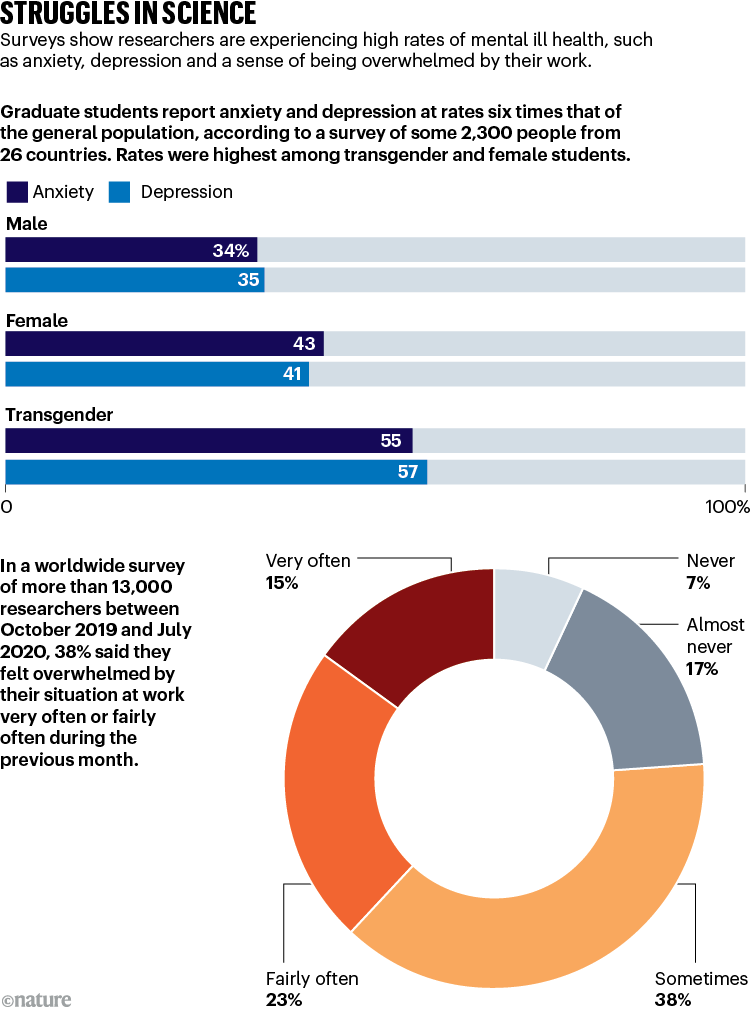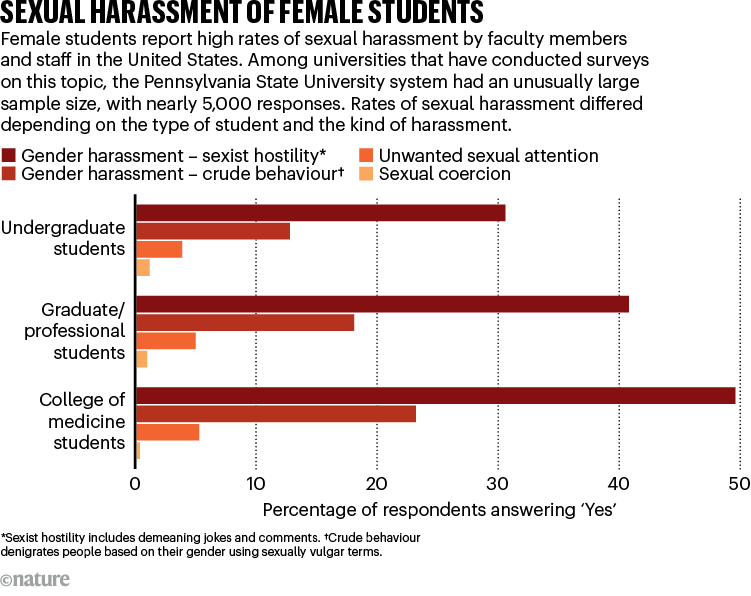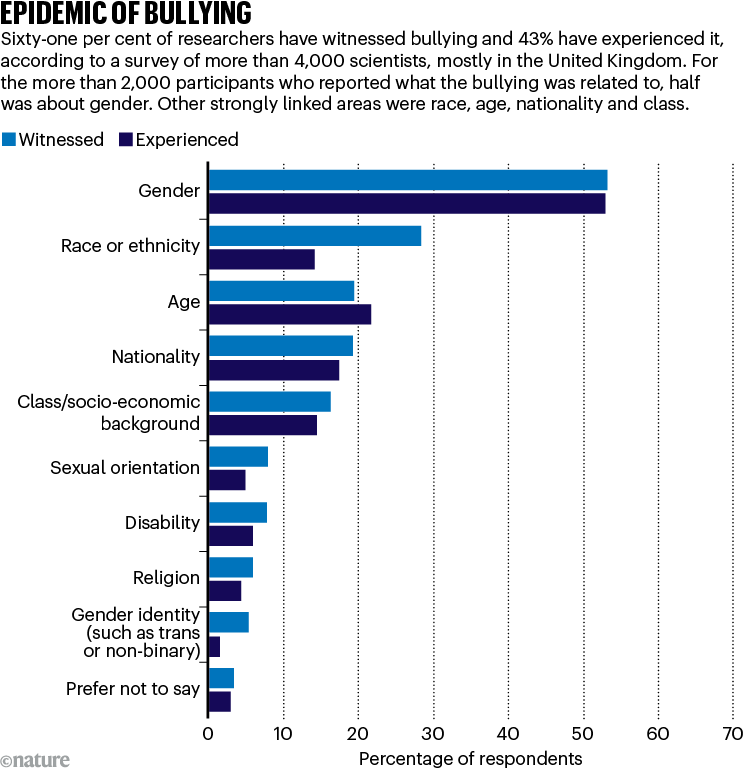A mental-health crisis is gripping science — toxic research culture is to blame

There is a mental-health crisis in science — at all career stages and across the world. Graduate students are being harassed and discriminated against, paid meagre wages, bullied, overworked and sometimes sexually assaulted. It doesn’t get much better for early-career researchers struggling to land long-term employment. And established senior researchers face immense pressure to win grants, publish in high-profile journals and maintain their reputations in highly competitive fields.
Scientists have raised concerns for years about the impacts of all these pressures on mental health. But a series of studies in the past few years are now providing hard data. And the findings show that the situation is dire.
Researchers are much more likely than the general population to experience depression and anxiety. And although the COVID-19 pandemic caused an increase in mental-health struggles, many argue that it only exacerbated problems that were already present. The recent studies, which have collectively surveyed tens of thousands of researchers worldwide, suggest that scientists’ mental-health struggles are a direct result of a toxic research culture.

Science careers and mental health
That is particularly true for members of under-represented groups, including women, non-binary individuals, people of colour, those from sexual and gender minorities (LGBTQ+) and students on low incomes. But they also affect senior researchers and scientists in different countries.
“Well-being and how to set healthy boundaries in your life and in your work is a fundamental skill,” says Sharon Milgram, director of the Office of Intramural Training and Education at the US National Institutes of Health (NIH). “I feel like there was a blind spot in myself and many of us, in that it took this data to wake us up.”
With hard numbers in hand, some argue that science is at the beginning of a movement — one that will encourage systemic changes to improve the mental health of researchers over generations to come. Others argue that change is happening too slowly for young scientists who are already fleeing science — an effect that could have grim consequences for the future of research and society itself.
A global problem
In 2015, Teresa Evans, who directed graduate biomedical career development at the University of Texas Health Science Center at San Antonio, learnt that her students were struggling. But when they came to her for advice, she felt ill-equipped to help.
So Evans started her own research, only to uncover a dearth of literature on the topic. Not only were there few resources on how to help students, but it was unclear how extensive mental-health problems were — compelling Evans to circulate her own survey to quantify the matter. She received 2,279 responses, mostly from PhD candidates, at 234 institutions across 26 countries.
The results, published in March 2018, represented the largest survey of its kind at the time. It revealed a global problem: 41% of respondents reported moderate to severe anxiety and 39% had moderate to severe depression1. Those levels are six times greater than in the general population (see ‘Struggles in science’). The data also suggested possible sources of these mental-health problems — anxiety and depression were often correlated with poor work–life balance and poor mentor relationships.

Sources: Left, Ref. 1; Right: Ref. 9
The rates varied significantly by gender: female, transgender and gender-nonconforming respondents were more likely to struggle with mental health than were their male counterparts. The prevalence of anxiety and depression was 55% and 57% for transgender and gender-nonconforming graduate students, 43% and 41% for women and 34% and 35% for men. That didn’t surprise Evans, because women are more prone to anxiety and depression than are men2.
But there was another, bigger factor at work: sexual harassment in science that disproportionately affects women. In 2014, Kathryn Clancy, an anthropologist at the University of Illinois in Urbana-Champaign, documented high rates of sexual harassment in field science3 . Then, in 2017, she and her colleagues surveyed 474 astronomers and planetary scientists, and found that 30% of women felt unsafe because of their gender (compared with 2% of men)4.
These studies encouraged the US National Academies of Sciences, Engineering, and Medicine to appoint a special committee to examine the issue in academic settings. In June 2018, it released a report that revealed pervasive and damaging sexual harassment in science5 (see ‘Sexual harassment of female students’).

Source: Ref. 5
It’s not just a problem in the United States. In 2020, Wellcome, a major biomedical research funder in London, surveyed more than 4,200 scientists from 87 countries across genders, career stages and disciplines, and found that 43% of participants had experienced bullying or harassment and 61% had witnessed it6 (see ‘Epidemic of bullying’). Many felt that it was “culturally systemic”, and 33% thought that leaders turned a blind eye to the behaviour.

Source: Ref. 6
In a 2021 Nature survey of more than 3,200 working scientists, nearly one-third said they had observed discrimination against or harassment of colleagues in their current job. The following year, another Nature survey of more than 3,200 PhD and master’s students found that 35% of scientists who identify as members of minority racial or ethnic groups said they had experienced harassment or discrimination during their graduate studies.
It’s no wonder there is a serious mental-health problem in science, say researchers. One study even found that the rates of burnout, depression and anxiety were comparable with those reported in ‘high-risk’ occupations such as health care7.
The Wellcome study6 found that 70% of respondents felt stressed on the average workday, and 34% had sought professional help for mental-health issues. Beyond harassment, many participants blamed funders and institutes that emphasize quantity over quality in terms of publishing and obtaining grants — all of which contribute to a poor work–life balance.
Another explanation suggested in the study6 is that many scientists see their work as a vocation, not just a job. Although that means researchers are passionate, it also presents a unique challenge, argues Eric Pellegrini, an astronomer who left the field last year to become an independent data scientist. “They get you to torture yourself by making this work part of your identity — it’s not a job, it’s not even a career, it’s a life choice,” he says. “And you buy into that for years until you figure out what it is. Take away a lot of the parts, make it more generic, and it’s just an abusive relationship.”
Pandemic pressures
That was the picture before 2020. Then the COVID-19 pandemic hit, and with it, an onslaught of further challenges.
In a 2020 survey of 5,247 graduate students in science, technology, engineering and mathematics from 9 institutions across the United States, 38% reported symptoms consistent with anxiety and 35% had depression8. These proportions represented large jumps from what the same team found in 2019. The number of students with depression doubled, and the prevalence of anxiety rose by 50%8.
“Our findings indicated that it was really a disaster,” says Igor Chirikov, a senior researcher at the Center for Studies in Higher Education at the University of California, Berkeley, who led the study.

Postdoctoral researchers and other academics demand higher salaries and better benefits during a strike against the University of California last December.Credit: Sarah Reingewirtz/MediaNews Group/Los Angeles Daily News/Getty
Chirikov’s team found that challenges in mental health were often associated with financial stress, which are acute for early-stage researchers. In the United States, for example, PhD students in the biological sciences earn salaries that are well below the cost of living. Postdoctoral researchers earn an average of $47,500 a year — a little more than half of the average annual salary for university graduates. Moreover, postdocs face constant upheaval, because they typically have to move to a new role every few years. Some researchers spend a decade or longer jumping from one short-term contract to the next.
Then, despite the years that scientists devote to training, many struggle to find a long-term job at a university, and this can drive young researchers out of science entirely. The 2020 Wellcome survey66 found that nearly half of the respondents who had left research reported that difficulty in finding a job was one reason. The two other common reasons included a negative impact on mental health and a desire for a better work–life balance.
Even if scientists land permanent positions, the competition never ends. In 2020, a survey designed by Cactus Communications, a science communication and technology company headquartered in Mumbai, India, analysed the opinions of 13,000 researchers in more than 160 countries. It found, for example, that 65% of respondents were under tremendous pressure to publish papers, secure grants and complete projects to maintain their reputation in the research community9. “That response is coming largely from more senior researchers, because they need to continue to be seen as bright as they once were,” says Abhishek Goel, co-founder and chief executive of Cactus Communications.
Beyond the pressure to perform, the study identified several other factors contributing to poor mental health among researchers, including long working hours and a culture in which stress and anxiety are normalized. Another factor mentioned by a large proportion of scientists was bullying and discrimination in their work environment. This was especially common for women, researchers identifying as gay and people of mixed race. Some 60% of the last group, for example, reported that they had experienced discrimination, harassment or bullying at work.
Although the study took place in 2020, most of these issues were present well before the COVID-19 pandemic.
One study, for example, surveyed more than 3,000 physicists and biologists in the United Kingdom, United States, Italy and India, and conducted in-depth interviews with more than 200 scientists. It found that the pandemic only exacerbated issues that were already present10.
“In our interviews, scientists said that the pandemic was really just the tipping point,” says study co-author Brandon Vaidyanathan, a sociologist at the Catholic University of America in Washington DC. “Things like burnout and emotional exhaustion had been happening beforehand and the pandemic laid them bare. It amplified these effects.”
Chance to change
As evidence of all these problems has grown, scientists are turning towards solutions. But exactly what needs to change is far from clear. “When we looked at the results from the study, we were actually quite upset and felt a little angry — helpless even,” Goel says. “We just felt that it would be extremely difficult to effect change.”
Still, many scientists agree that the first step is for mental health to become a mainstream topic of conversation — a change that might already be afoot. Since Evans and her colleagues published their study in 2018, they and other scientists have been invited to numerous institutions and conferences to talk about the issue. And the most recent decadal survey of US astronomy and astrophysics, in 2021, conducted by the National Academies to set funding priorities every decade, discussed the need to address harassment and discrimination in the community.

Mental health of graduate students sorely overlooked
That’s huge progress, argued Jennifer Wiseman, an astronomer at NASA’s Goddard Space Flight Center in Greenbelt, Maryland, at a meeting of the American Astronomical Society (AAS) in Seattle, Washington, in January. Other programmes are looking to tackle the representation and equity issues that so often coincide with harassment, abuse and mental illness. For instance, NASA recently reviewed its Hubble Fellowship Program, which provides esteemed postdoctoral positions, in order to diversify its reach. Major grant programmes, such as those of the US Department of Energy, now require a plan that outlines how the proposing team will work against barriers to create and sustain an inclusive work environment. “These examples highlight actions being taken in our astronomical field in response to shifting values that now prioritize inclusivity and the well-being of our communities as central to scientific success,” Wiseman said at the meeting.
Milgram has long viewed mental health as an essential component of a successful researcher’s skill set. Since 2020, the NIH Office of Intramural Training and Education has offered a course called Becoming a Resilient Scientist, with topics that range from impostor syndrome to developing better relationships with mentors. Its 25,000 participants — including undergraduates, graduates, postdocs and medical students recruited from the NIH and various extramural institutions — have reported decreases in anxiety, depression and presenteeism (that is, not fully functioning in the workplace because of stress). In the past two years, Milgram’s team has offered a parallel programme called Raising a Resilient Scientist, which is designed to help faculty members and administrators develop better mentoring skills and work on their personal mental health.
Grassroots initiatives by graduate students and postdocs have led to various events and workshops, even yoga meet-ups. Drives to form PhD student and postdoc unions on US campuses have also sought guarantees of better working conditions. “It is the beginning of a movement that hopefully over generations of academics will result in long-term change,” Evans says. “And I feel like we have all the pieces to see that happen. It just takes time.”
But others argue that science needs larger, systemic changes — such as zero tolerance for abuse. Although institutions and conferences are strengthening value statements, codes of conduct and enforcement, there is still a lot of work to be done, Wiseman said at the AAS meeting. Researchers need to be able to raise concerns without fear of reprisals or prejudice. In Goel’s survey9, for example, 49% of respondents said that they would not seek support because they would worry about retaliation.
Many argue that there needs to be drastic changes to funding structures. “These models are just really dated,” says Sheila Kanani, the education outreach and diversity officer at the Royal Astronomical Society in London, which surveyed 650 astronomers and physicists in 2020 and found a systemic bullying problem. “The whole system needs a massive overhaul.” As part of that, she and others say that funding should not be entirely based on publications, but rather on a healthy work environment — one that considers the mental health of researchers and the rigour of their work, including ideas that might never land in an academic journal.
Without dramatic change, it’s possible that young researchers will continue to flee the field. “This really is a problem that could potentially affect the future of science if we can’t retain young talent,” Vaidyanathan says. “We owe it to future generations of scientists to create more hospitable workplaces that just allow you to just do the science.”





